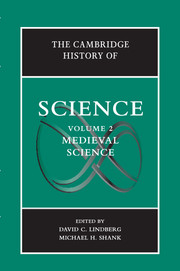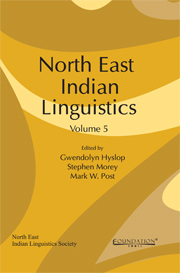Refine search
Actions for selected content:
10306 results in History of science: general interest
25 - ANATOMY, PHYSIOLOGY, AND MEDICAL THEORY
-
-
- Book:
- The Cambridge History of Science
- Published online:
- 05 September 2013
- Print publication:
- 07 October 2013, pp 590-610
-
- Chapter
- Export citation
14 - Translation and Transmission of Greek and Islamic Science to Latin Christendom
-
-
- Book:
- The Cambridge History of Science
- Published online:
- 05 September 2013
- Print publication:
- 07 October 2013, pp 341-364
-
- Chapter
- Export citation
7 - SCIENCE IN THE BYZANTINE EMPIRE
-
-
- Book:
- The Cambridge History of Science
- Published online:
- 05 September 2013
- Print publication:
- 07 October 2013, pp 190-206
-
- Chapter
- Export citation
9 - The Organization of Knowledge
-
-
- Book:
- The Cambridge History of Science
- Published online:
- 05 September 2013
- Print publication:
- 07 October 2013, pp 240-267
-
- Chapter
- Export citation
24 - Medieval Natural History
-
-
- Book:
- The Cambridge History of Science
- Published online:
- 05 September 2013
- Print publication:
- 07 October 2013, pp 569-589
-
- Chapter
- Export citation
22 - Logic
-
-
- Book:
- The Cambridge History of Science
- Published online:
- 05 September 2013
- Print publication:
- 07 October 2013, pp 532-547
-
- Chapter
- Export citation
13 - EARLY-MEDIEVAL MEDICINE AND NATURAL SCIENCE
-
-
- Book:
- The Cambridge History of Science
- Published online:
- 05 September 2013
- Print publication:
- 07 October 2013, pp 323-340
-
- Chapter
- Export citation
Index
-
- Book:
- The Cambridge History of Science
- Published online:
- 05 September 2013
- Print publication:
- 07 October 2013, pp 645-677
-
- Chapter
- Export citation
12 - Early-Medieval Cosmology, Astronomy, and Mathematics
-
-
- Book:
- The Cambridge History of Science
- Published online:
- 05 September 2013
- Print publication:
- 07 October 2013, pp 302-322
-
- Chapter
- Export citation
2 - Islamic Mathematics
-
-
- Book:
- The Cambridge History of Science
- Published online:
- 05 September 2013
- Print publication:
- 07 October 2013, pp 62-83
-
- Chapter
- Export citation
16 - MEDIEVAL ALCHEMY
-
-
- Book:
- The Cambridge History of Science
- Published online:
- 05 September 2013
- Print publication:
- 07 October 2013, pp 385-403
-
- Chapter
- Export citation
17 - Change and Motion
-
-
- Book:
- The Cambridge History of Science
- Published online:
- 05 September 2013
- Print publication:
- 07 October 2013, pp 404-435
-
- Chapter
- Export citation
General Editors' Preface
-
- Book:
- The Cambridge History of Science
- Published online:
- 05 September 2013
- Print publication:
- 07 October 2013, pp xxiii-xxiv
-
- Chapter
- Export citation
15 - THE TWELFTH-CENTURY RENAISSANCE
-
-
- Book:
- The Cambridge History of Science
- Published online:
- 05 September 2013
- Print publication:
- 07 October 2013, pp 365-384
-
- Chapter
- Export citation
Illustrations
-
- Book:
- The Cambridge History of Science
- Published online:
- 05 September 2013
- Print publication:
- 07 October 2013, pp xv-xvi
-
- Chapter
- Export citation
27 - TECHNOLOGY AND SCIENCE
-
-
- Book:
- The Cambridge History of Science
- Published online:
- 05 September 2013
- Print publication:
- 07 October 2013, pp 630-644
-
- Chapter
- Export citation
10 - SCIENCE AND THE MEDIEVAL CHURCH
-
-
- Book:
- The Cambridge History of Science
- Published online:
- 05 September 2013
- Print publication:
- 07 October 2013, pp 268-285
-
- Chapter
- Export citation
3 - THE MIXED MATHEMATICAL SCIENCES
-
-
- Book:
- The Cambridge History of Science
- Published online:
- 05 September 2013
- Print publication:
- 07 October 2013, pp 84-108
-
- Chapter
- Export citation

The Cambridge History of Science
-
- Published online:
- 05 September 2013
- Print publication:
- 07 October 2013

North East Indian Linguistics
-
- Published by:
- Foundation Books
- Published online:
- 05 September 2013
- Print publication:
- 01 March 2013
